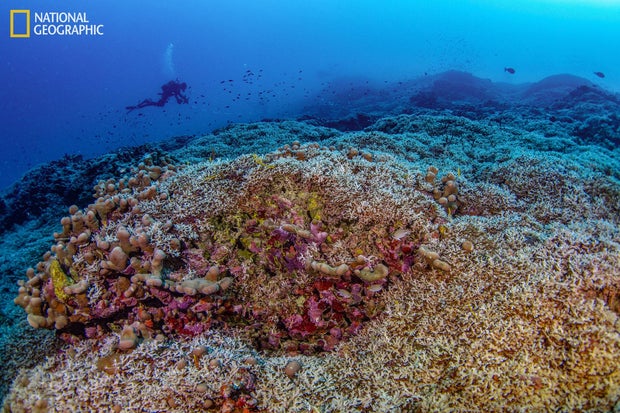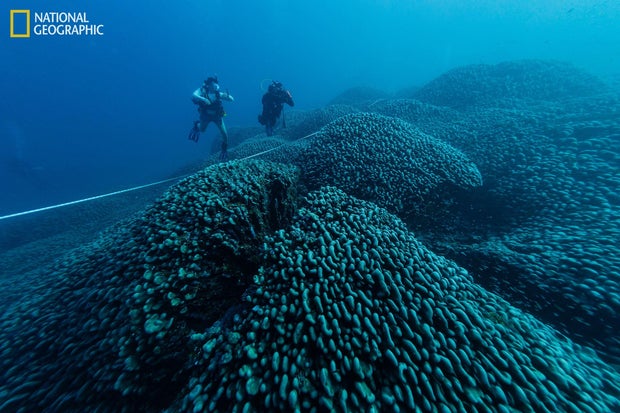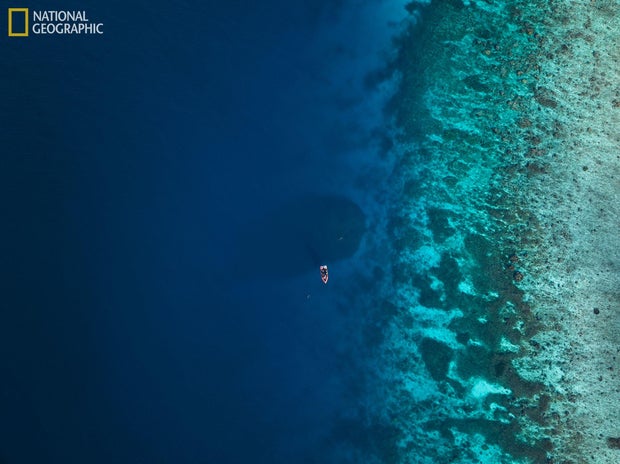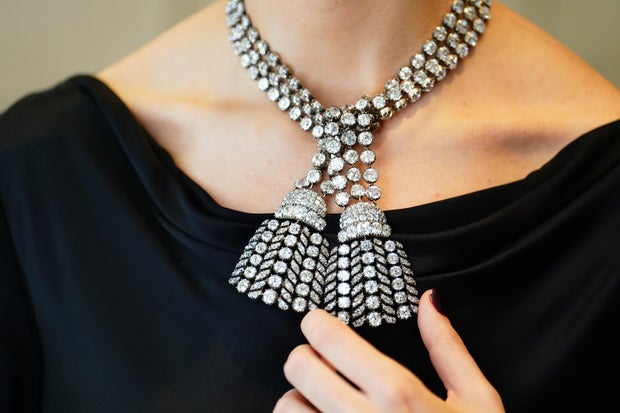CBS News
How the cicada invasion is bringing people together

Kristi Shirley has been captivated by the army of cicadas marching up trees at a park near her home in southern Illinois.
“There’s nothing like it. It’s just like, wow, is this what we’re watching in front of our eyes?” Shirley said.
By now, you’ve probably seen the headlines: two groups of periodical cicadas are emerging at the same time for the first time in two centuries, with billions of the noisy bugs showing up in 16 U.S. states.
But biologist Gene Kritsky says there may be a deeper meaning to this insect invasion. The cicadas are coming together at a time when it’s all too easy to see what keeps people apart, as if nature is (once again) trying to capture our collective attention.
In April, large crowds gathered to watch the total eclipse of the sun. Earlier this month, millions of people marveled as the northern lights danced across the night sky. The two events were accurately predicted by astronomers.
“Now we’re seeing periodical cicadas coming out of the ground, predicted by entomologists. And at a time when people have lost faith in science, this shows that science works and we get it right,” Kritsky said.
These natural events offer a kind of shared experience for people to set aside their differences and come together to marvel at Mother Nature.
“I was at an eclipse party, and there were people there from all political persuasions and we didn’t talk politics. We watched the solar eclipse,” Kritsky said.
Now Kritsky has created an app called Cicada Safari to track where and when the bugs arrive. It’s bringing together people who find something special in the unique-looking insects — people like Shirley, who calls herself a “super user” of the app, and Blaine Rothauser, who struck up a conversation with Shirley about the cicadas just minutes after meeting her at the park near her home.
The power of the cicadas seemed to give these total strangers something to bond over. Instead of questions like ‘What you do?’, ‘What you believe in?’ or ‘Who you support?’, Krisky says that “what’s important is, are we all curious?”
And while it may often feel like people live in separate worlds, we actually share one.
CBS News
Sneak peek: The Plot to Eliminate Alyssa Burkett

Watch CBS News
Be the first to know
Get browser notifications for breaking news, live events, and exclusive reporting.
CBS News
Scientists say they’ve discovered the world’s biggest coral, so huge it was mistaken for a shipwreck

Scientists say they have found the world’s largest coral near the Pacific’s Solomon Islands, announcing Thursday a major discovery “pulsing with life and color.” The coral is so immense that researchers sailing the crystal waters of the Solomon archipelago initially thought they’d stumbled across a hulking shipwreck.
“Just when we think there is nothing left to discover on planet Earth, we find a massive coral made of nearly one billion little polyps, pulsing with life and color,” marine ecologist Enric Sala said.
The standalone structure, formed from a “complex network” of tiny coral polyps, has likely been growing for 300 years or more, the researchers said.
Manu San Félix/National Geographic Pristine Seas
At about 111 feet wide and 104 feet long, the team said the “mega coral” was three times bigger than the previous record holder — a coral dubbed “Big Momma” in American Samoa. The massive coral is not a coral reef, structures that can be far larger but are comprised of many distinct coral colonies, they explained.
“While Big Momma looked like a huge scoop of ice cream plopped down on the reef, this newly discovered coral is as if the ice cream started to melt, spreading forever along the seafloor,” said lead scientist Molly Timmers.
It’s longer than a blue whale and thought to be “so colossal” that it could be seen from space.
ManuSan Félix/National Geographic Pristine Seas
The coral was discovered at the southeastern tip of the Solomon Islands, in an area known as the Three Sisters. It was spotted by a National Geographic team embarking on a scientific expedition in the region.
Hotter and more acidic oceans have drained the life from corals in many of the region’s tropical waters, a process called bleaching, including Australia’s famed Great Barrier Reef. But this latest discovery offered a small glimmer of hope, the research team said.
“While the nearby shallow reefs were degraded due to warmer seas, witnessing this large healthy coral oasis in slightly deeper waters is a beacon of hope,” said coral scientist Eric Brown.
The lush rainforests and pristine waters of the Solomon Islands have long been celebrated for their ecological diversity. Wildlife observations made in the area in the 1920s helped prove a key part of Charles Darwin’s theory of evolution.
“There is so much to learn about the richness of marine life and the ocean ecosystem, but this finding opens doors of knowledge,” said top Solomon Islands official Collin Beck. “More scientific research is needed to better understand our rich biodiversity and our planet.”
Steve Spence/National Geographic Pristine Seas
The discovery was announced as representatives from around the world meet in Baku, Azerbaijan for the COP29 United Nations summit on climate change.
The Solomon Islands national climate minister, Trevor Manemahaga, told CBS News’ partner network BBC News at the summit that his nation was proud to be the home of the massive, newly discovered coral.
“We want the world to know, that this is a special place, and it needs to be protected,” he told the BBC. “We rely mostly on marine resources for economic survival, so coral is very, very important.”
Small, low-lying island nations such as the Solomons are among the most vulnerable to the increasing effects of climate change and sea-level rise.
CBS News
Mysterious diamond necklace — possibly linked to Marie Antoinette’s demise — sells for $4.8 million

A mysterious diamond-laden necklace with possible links to a scandal that contributed to the downfall of Marie Antoinette, sold for $4.8 million at an auction in Geneva Wednesday.
The 18th century jewel containing around 300 carats of diamonds had been estimated to sell at the Sotheby’s Royal and Noble Jewels sale for $1.8-2.8 million.
But after energetic bidding, the hammer price ticked in at 3.55 million Swiss francs ($4 million), and Sotheby’s listed the final price after taxes and commissions at 4.26 million francs ($4.81 million).
The unidentified buyer, who put in her bid over the phone, was “ecstatic,” Andres White Correal, chairman of the Sotheby’s jewelry department, told AFP.
“She was ready to fight and she did,” he said, adding that it had been “an electric night.”
Jordan Pettitt/PA Images via Getty Images
“There is obviously a niche in the market for historical jewels with fabulous provenances… People are not only buying the object, but they’re buying all the history that is attached to it,” he said.
Some of the diamonds in the piece are believed to stem from the jewel at the center of the “Diamond Necklace Affair” — a scandal in the 1780s that further tarnished the reputation of France’s last queen, Marie Antoinette, and boosted support for the coming French Revolution.
The auction house said the necklace, composed of three rows of diamonds finished with a diamond tassel at each end, had emerged “miraculously intact” from a private Asian collection to make its first public appearance in 50 years.
“This spectacular antique jewel is an incredible survivor of history,” it said in a statement prior to the sale.
Describing the massive Georgian-era piece as “rare and highly important,” Sotheby’s said it had likely been created in the decade preceding the French Revolution.
“The jewel has passed from families to families. We can start at the early 20th century when it was part of the collection of the Marquesses of Anglesey,” White Correal said.
Members of this aristocratic family are believed to have worn the necklace twice in public: once at the 1937 coronation of King George VI and once at his daughter Queen Elizabeth II’s coronation in 1953.
“Spectacular piece of history”
Beyond that, little is known of the necklace, including who designed it and for whom it was commissioned, although the auction house believes that such an impressive antique jewel could only have been created for a royal family.
Sotheby’s said it was likely that some of the diamonds featured in the piece came from the famous necklace from the scandal that engulfed Marie Antoinette.
That scandal involved a hard-up noblewoman named Jeanne de la Motte who pretended to be a confidante of the queen, and managed to acquire a lavish diamond-studded necklace in her name, against a promise of a later payment.
On Oct. 16, 1793, Marie Antoinette was guillotined — but it turned she was actually innocent of the necklace fraud that she was accused of.
While the queen was later found to be blameless in the affair, the scandal still deepened the perception of her careless extravagance, adding to the anger that would unleash the revolution.
Sotheby’s said the diamonds in the necklace sold Wednesday were likely sourced from “the legendary Golconda mines in India” — considered to produce the purest and most dazzling diamonds.
“The fortunate buyer has walked away with a spectacular piece of history,” Tobias Kormind, head of Europe’s largest online diamond jeweler 77 Diamonds, said in a statement.
“With exceptional quality diamonds from the legendary, now extinct Indian Golconda mines, the history of a possible link to Marie Antoinette along with the fact that it was worn to two coronations, all make this 18th Century necklace truly special.”
In 2018, a large, drop-shaped natural pearl pendant sold for more than $36 million at a rare auction of jewelry that once belonged to Marie Antoinette. The “Queen Marie Antoinette’s Pearl,” a diamond-and-pearl pendant, was among the highlight offerings on the block at the Sotheby’s sale of jewelry from the Bourbon-Parma dynasty in Geneva.












